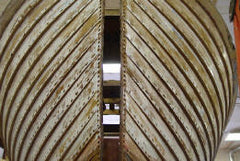Your Cart is Empty
Sold Out
This Sami made Lapstrake Lapland Sleigh was discovered by our Swedish Antique dealer friend. It was made by the locals for reindeer to pull supplies (and their families) through the snowy forests of the northern most part of Finland (Lapland). (Sami are the people of Lapland, Lapstrake is the construction: see below)
Acquired in 1999 and shipped to Florida in 2003, it was housed in the Winter Sports Museum in Colorado until 2010. We at Vintage Winter have been the fortunate owners and caretakers since the Museum closed and decommissioned their collections.
Easily mistaken for a CANOE! The torpedo shape makes it look more like a swift water floating device, but we are confident this was used on Frozen snow (see the single sleigh runner down the center on the base).
The metal ring on the back is used to connect a stabilizing rope and was likely held by the Sleigh owner skiing behind his Reindeer.
An incredible piece of history!
About Lapstrake Construction:
Lapstrake refers to the method of construction. The planks actually "lap" one edge over another as opposed to butting together at their edges like batten-seam or straight-carvel construction. This method has been used for hundreds of years and is sometimes referred to as "clinker-built,". It adds strength to the hull where the lap occurs doubling the plank thickness and essentially forming a "stringer" at each plank edge. These longitudinal stiffeners allow the boat or SLEIGH to be designed with lighter material reducing the weight of the vessel.
Those who are familiar with lapstrake boats know that they have more stability and sea kindness than flat-bottomed boats. Each one of those "laps" at the bow acts as a sort of shock absorber, turning the force of breaking water (snow) to the side and, following dozens of stabilizing fins. Brand-new fiberglass speed boats also feature these protruding laps.
